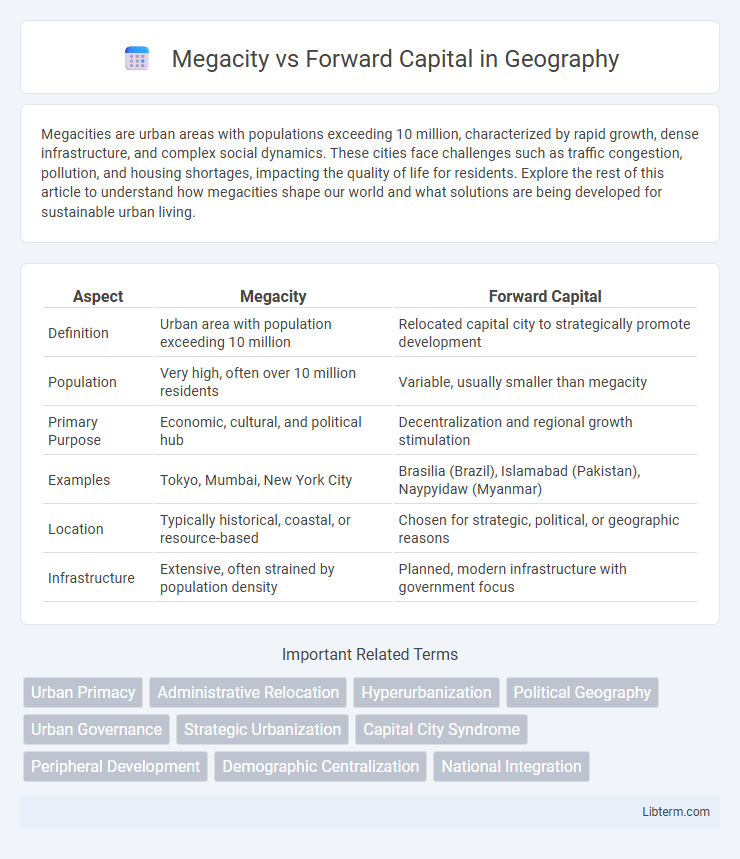Megacities are urban areas with populations exceeding 10 million, characterized by rapid growth, dense infrastructure, and complex social dynamics. These cities face challenges such as traffic congestion, pollution, and housing shortages, impacting the quality of life for residents. Explore the rest of this article to understand how megacities shape our world and what solutions are being developed for sustainable urban living.
Table of Comparison
| Aspect | Megacity | Forward Capital |
|---|---|---|
| Definition | Urban area with population exceeding 10 million | Relocated capital city to strategically promote development |
| Population | Very high, often over 10 million residents | Variable, usually smaller than megacity |
| Primary Purpose | Economic, cultural, and political hub | Decentralization and regional growth stimulation |
| Examples | Tokyo, Mumbai, New York City | Brasilia (Brazil), Islamabad (Pakistan), Naypyidaw (Myanmar) |
| Location | Typically historical, coastal, or resource-based | Chosen for strategic, political, or geographic reasons |
| Infrastructure | Extensive, often strained by population density | Planned, modern infrastructure with government focus |
Introduction to Megacities and Forward Capitals
Megacities are densely populated urban areas typically exceeding 10 million residents, serving as economic, cultural, and political hubs with complex infrastructure and significant environmental challenges. Forward capitals are strategically relocated administrative centers designed to promote regional development, national security, and political decentralization, often positioned away from traditional economic powerhouses. Understanding the roles of megacities and forward capitals reveals contrasting approaches to urban planning, governance, and national growth dynamics.
Historical Evolution of Urban Power Centers
Megacities emerged as dominant urban power centers during the Industrial Revolution, fueled by rapid population growth and economic centralization, while forward capitals were established strategically to redistribute political and economic influence. The historical evolution of urban power centers reflects the tension between existing megacities like London or Tokyo and planned forward capitals such as Brasilia or Canberra, designed to alleviate congestion and promote regional development. Urban planning and state policies have continuously shaped these centers, balancing historical prominence with strategic foresight in shifting national power dynamics.
Defining Features: Megacities vs Forward Capitals
Megacities are characterized by extremely high population densities, extensive urban sprawl, and significant economic hubs often exceeding 10 million residents, driving regional and global influence through diverse industries and infrastructure. Forward capitals are strategically relocated administrative centers designed to stimulate development in less populated or geopolitically significant areas, emphasizing planned urban growth and political decentralization. Unlike megacities that evolve organically due to economic magnetism, forward capitals are deliberate governmental initiatives aimed at balancing national development and reducing congestion in primary cities.
Factors Driving the Rise of Megacities
Rapid urbanization fueled by economic opportunities and industrialization is a primary factor driving the rise of megacities, attracting large populations seeking better livelihoods. Infrastructure development, improved transportation networks, and technological advancements enable these urban centers to support millions of residents efficiently. Government policies favoring urban expansion and globalization trends also contribute to the growth of megacities, contrasting with forward capitals designed primarily to decentralize congestion and promote regional development.
Strategic Motivations Behind Forward Capital Relocation
Forward capital relocation is often driven by strategic motivations such as reducing congestion in megacities, promoting regional development, and enhancing national security. Governments aim to decentralize political power and economic activity by situating the capital in a less congested, more geographically central area to improve administrative efficiency and disaster resilience. This strategy also fosters balanced population distribution, alleviating environmental pressures and infrastructure strain on overcrowded megacities.
Urban Planning and Infrastructural Challenges
Megacities face significant urban planning challenges due to high population density, leading to congestion, inadequate housing, and strained public services. Forward capitals are strategically planned to distribute population growth and economic activities more evenly, reducing pressure on congested megacities. Infrastructure development in forward capitals emphasizes sustainable transport, efficient utilities, and balanced land use to foster long-term urban resilience and economic diversification.
Economic Impacts and Opportunities
Megacities drive substantial economic growth through large-scale consumer markets, diverse labor pools, and extensive infrastructure, attracting both domestic and foreign investment. Forward capitals, strategically relocated cities designed to decentralize economic activity, stimulate regional development, reduce congestion, and create new business hubs, balancing national growth. Both models present unique opportunities: megacities benefit from network effects and innovation clusters, while forward capitals can leverage planned urbanization to optimize resource distribution and foster equitable economic expansion.
Social and Environmental Considerations
Megacities often face significant social challenges such as overcrowding, inadequate infrastructure, and heightened pollution levels, which exacerbate inequality and reduce quality of life. Forward capitals are strategically designed to alleviate urban stress by redistributing population density and promoting sustainable development through planned infrastructure and green spaces. Social equity and environmental sustainability are central to forward capital planning, aiming to create balanced urban environments with improved public services and reduced ecological footprints.
Global Case Studies: Comparing Notable Examples
Shanghai exemplifies a megacity with its massive population, economic hubs, and extensive infrastructure driving China's global influence. In contrast, Brazil's Brasilia represents a forward capital intentionally developed to promote political decentralization and regional growth away from the coastal megacity Rio de Janeiro. These cases reveal how megacities concentrate economic power while forward capitals strategically redistribute administrative functions to foster balanced national development.
The Future of Urban Development: Trends and Predictions
Megacities, characterized by populations exceeding 10 million, face challenges such as congestion, pollution, and strained infrastructure, driving the trend toward the development of forward capitals as strategic urban centers designed for sustainability and innovation. Forward capitals integrate smart technology, green spaces, and efficient governance models to address rapid urbanization while promoting economic decentralization. Future urban development predicts increased investment in these planned cities to balance growth, reduce megacity pressure, and foster resilient, inclusive metropolitan regions worldwide.
Megacity Infographic

 libterm.com
libterm.com